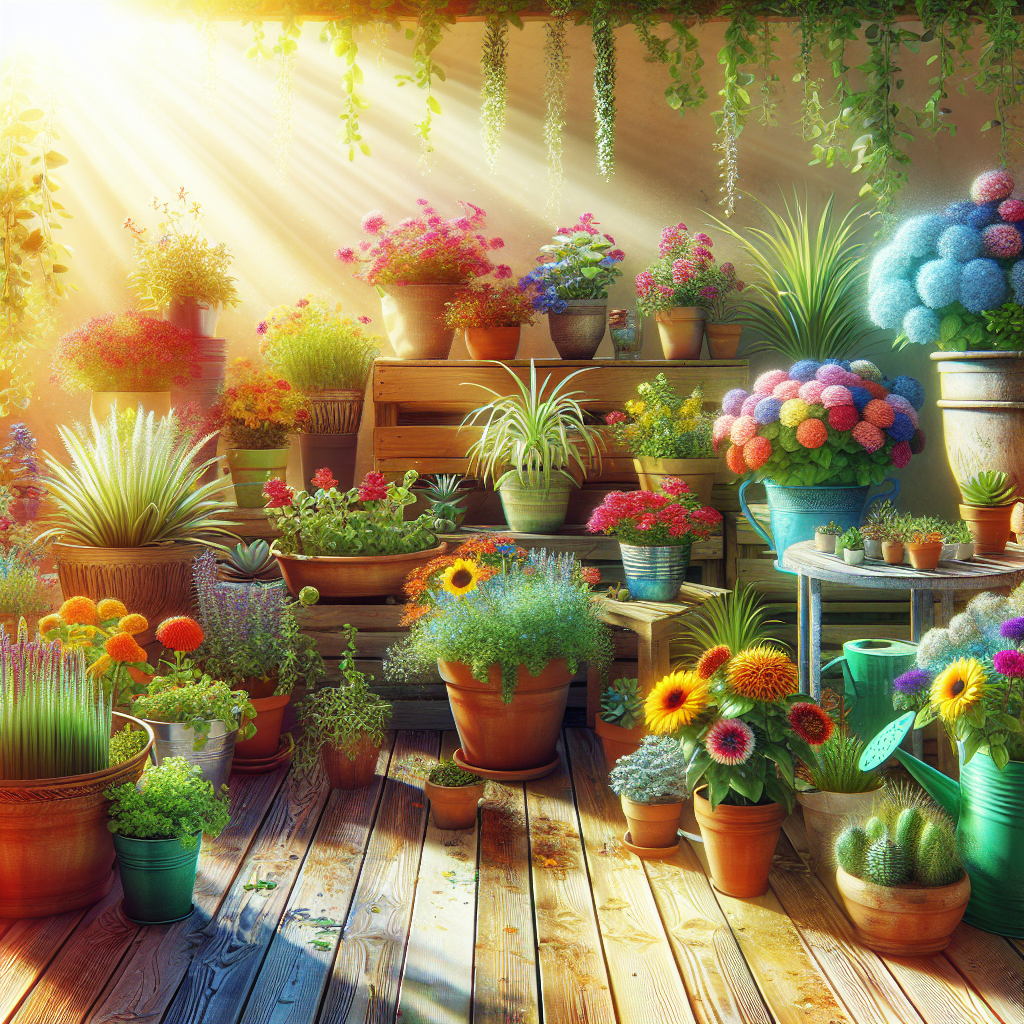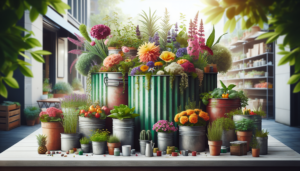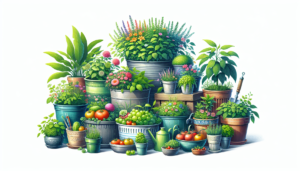
If you’ve always dreamed of having your own garden but don’t have the space or time to maintain a full-fledged one, container gardening might just be the solution for you. Whether you live in an apartment with limited outdoor space or simply want to add a touch of greenery to your patio or balcony, container gardening offers a convenient and flexible way to grow plants. With the right approach and a few key tips, you can easily create a flourishing garden in containers, bringing nature into your living space and enjoying the rewards of your own green thumb. So, let’s explore the world of container gardening and discover how you can make it work for you.
Selecting the Right Containers
When it comes to container gardening, selecting the right containers is essential for the success of your plants. Consider the size and shape of the container. Different plants have different root systems and space requirements, so choose containers that are suitable for the plants you intend to grow. For example, deep containers are ideal for plants with taproots, while shallow ones are better for plants with fibrous root systems.
Another important factor to consider is the drainage of the containers. Good drainage is crucial to prevent waterlogged roots and root rot. Look for containers with drainage holes at the bottom to allow excess water to escape. If you encounter a container without drainage holes that you really want to use, you can drill holes yourself or create a drainage layer at the bottom of the container using gravel or broken pottery.
The material of the containers is also important. Opt for containers made of sturdy materials that can withstand outdoor conditions, such as ceramic, terracotta, or plastic. Avoid containers that may crack or break easily, especially in extreme weather conditions like frost or intense heat.
Lastly, consider the weight and portability of the containers. If you plan to move your containers around frequently or have limited strength, choose lightweight materials or invest in containers with built-in wheels for easy mobility.
Choosing the Right Soil and Fertilizer
The soil is the foundation of your container garden, and choosing the right soil and fertilizer is vital for the health and growth of your plants. Using a well-draining potting mix is essential to prevent water from pooling around the roots. Look for potting mixes specifically labeled as suitable for containers or make your own by combining equal parts of compost, perlite, and vermiculite.
To further enhance the soil’s fertility, amend the potting mix with organic matter. This can be in the form of well-rotted compost, worm castings, or aged manure. Organic matter improves soil structure, retains moisture, and provides essential nutrients to the plants.
In addition to a good soil mix, your container plants will benefit from regular fertilization. Choose a slow-release fertilizer that gradually releases nutrients over time or opt for a liquid fertilizer that can be mixed with water and applied directly to the plants. Follow the instructions on the fertilizer packaging to ensure proper application and avoid over-fertilizing, which can lead to nutrient burn.
Selecting the Ideal Location
The location of your container garden plays a significant role in the success of your plants. Consider the amount of sunlight needed by the plants you intend to grow. Some plants thrive in full sun and require at least six hours of direct sunlight per day, while others prefer partial shade or even full shade. Observe your outdoor space to determine which areas receive the appropriate amount of sunlight for your chosen plants.
Extreme temperature conditions can be detrimental to container plants. Avoid placing your containers in areas that experience extreme fluctuations in temperature, such as near air conditioning units or in direct sunlight against a wall that absorbs heat. Aim for a location with relatively stable temperatures throughout the day.
Wind exposure is another important factor to consider. Strong winds can dry out the soil quickly and damage fragile plants. If your chosen location is prone to strong winds, consider adding windbreaks such as trellises, fences, or shrubs to protect your plants.
Assess the availability of water nearby. Container plants may require more frequent watering compared to plants in the ground, so having a nearby water source makes plant care more convenient. Consider the proximity of a hose, watering can, or rainwater collection system to ensure easy access to water.
Deciding on the Right Plants
Choosing the right plants is crucial for a thriving container garden. Consider the mature size of the plants you want to grow. Some plants, like tomatoes or peppers, can become quite large and may require larger or deeper containers. On the other hand, smaller plants like herbs or lettuces can be grown in shallower containers or even repurposed containers such as old pots or tins.
Select plants that have similar water and sunlight requirements. This will make it easier to care for your container garden as you can water and provide sunlight to them together, rather than having to individually cater to each plant’s needs. This also helps to prevent under or over-watering certain plants, which can be detrimental to their growth and health.
Choose plants that are well-suited to the area’s climate. Consider the average temperature range, humidity levels, and seasonal variations in your region. Some plants thrive in cooler climates, while others prefer hot and humid conditions. Research the specific plant’s temperature and climatic preferences to ensure they will flourish in your container garden.
Caring for Your Container Garden
Maintaining your container garden is essential to ensure the health and vitality of your plants. Proper watering is crucial for the success of container plants. The frequency of watering will depend on various factors such as the weather, plant species, and container size. As a general rule, water the plants when the top inch of the soil feels dry, but avoid overwatering, as it can lead to root rot. Take note of any specific watering requirements for the plants you have chosen.
Fertilizing your plants regularly is important to replenish the nutrients in the soil. Follow the recommended dosage and frequency indicated on the fertilizer packaging. Over-fertilization can harm your plants, so it’s important to strike the right balance.
Pruning and trimming your plants as needed helps maintain their shape, encourage bushier growth, and improve air circulation. Remove any dead or yellowing leaves, spent flowers, and overgrown branches. Prune with clean and sharp tools to avoid causing damage or introducing diseases.
Addressing pests and diseases promptly is essential to prevent them from spreading and causing significant damage. Inspect your plants regularly for signs of pests like aphids, mealybugs, or snails. Treat any infestations using organic or chemical pest control methods, depending on your gardening preferences. Similarly, promptly identify and address any signs of diseases such as fungal infections. Remove affected plant parts and consider applying organic fungicides if necessary.
Managing Space Effectively
Effective space management is essential, especially if you have limited space for your container garden. Consider the available space and plan accordingly to maximize your growing area.
Utilize vertical space by incorporating hanging or wall-mounted containers. This allows you to grow plants vertically, taking advantage of unused overhead space. Hanging baskets are perfect for trailing plants like ivy or petunias. Wall-mounted containers can be used for herbs or small flowering plants, adding beauty and functionality to your walls or fences.
Combining plants that have similar growth habits can save space and ensure proper plant growth. For example, planting bushy or spreading plants together can fill out a single container, creating a lush and full display without overcrowding individual plants.
Creating a Beautiful and Functional Display
Container gardening not only provides the opportunity to grow plants but also allows for the creation of beautiful and functional displays. Choose plants with complementary colors and textures to create visually appealing combinations. Consider contrasting foliage colors or flowers of various heights to add interest and depth to your container garden.
Think about the overall design and aesthetics of your container garden. Consider the style and theme you want to achieve. Whether you prefer a formal and structured look or a more casual and whimsical display, select containers and plants that align with your desired design.
Add features like trellises or decorative elements to further enhance the visual appeal of your container garden. Trellises provide vertical support for climbing plants like tomatoes or cucumbers, adding height and interest to your garden. Decorative elements such as statues, lanterns, or colored glass orbs can add personality and charm to your container garden.
Dealing with Common Container Gardening Challenges
Container gardening comes with its own set of challenges, but with proper care and attention, these can be overcome.
Preventing overwatering and root rot requires proper watering techniques and well-draining soil. Remember to water your plants only when the top inch of the soil feels dry. Ensure that your containers have adequate drainage, and consider using a moisture meter to gauge the moisture levels in the soil.
Managing plant overcrowding is important to prevent competition for resources and ensure proper plant growth. Remove any plants that have outgrown their containers or are overshadowing others. Consider repotting or dividing plants when necessary to maintain a healthy balance.
Protecting plants from extreme weather conditions is crucial for their survival. In hot weather, provide shade or move containers to a cooler spot during the peak heat of the day. During cold weather, consider insulating your containers with bubble wrap or moving them to a sheltered area to prevent freezing.
Dealing with specific pests and diseases requires vigilance and prompt action. Identify the pests or diseases affecting your plants and research appropriate organic or chemical control methods. Consider implementing preventive measures such as using insecticidal soaps or applying organic fungicides before an infestation occurs.
Harvesting and Preserving Your Container Garden
The joy of container gardening extends beyond growing and nurturing plants. Eventually, the time will come to harvest and enjoy the fruits of your labor. Timing the harvest correctly is crucial to ensure the best flavor and nutritional value. Research the specific plant’s maturity indicators, such as color or size changes, and harvest accordingly.
Properly storing and preserving your harvested produce is essential to maximize their shelf life. Certain fruits and vegetables can be stored in a cool and dry place, while others benefit from refrigeration. Research the recommended storage conditions for each type of produce to maintain their quality for as long as possible. Consider preserving your harvest through canning, freezing, or drying to enjoy the fruits of your container garden throughout the year.
Experimenting with Different Container Gardening Techniques
Container gardening offers plenty of opportunities for experimentation and creativity. Consider exploring different techniques to further enhance your gardening experience.
Vertical gardening allows you to maximize your space by growing plants vertically. By utilizing trellises, stakes, or even repurposed items like pallets, you can create a vertical garden filled with climbing or trailing plants. This technique is perfect for small spaces or when you want to add a unique element to your container garden.
Hydroponic container gardening is a soilless method that uses nutrient-rich water or inert mediums like perlite or coconut coir. This technique allows for precise control over nutrient levels and water management, resulting in faster growth and higher yields. Research and gather the necessary supplies and knowledge to embark on this exciting adventure.
Container gardening is often associated with small spaces, but it can also be adapted to larger areas. Whether you have a balcony, patio, or even a large backyard, container gardening can provide an element of beauty and versatility to any space. Experiment with different plant combinations, container arrangements, or themed gardens to truly make the most of your available space.
In conclusion, container gardening offers a wonderful opportunity to grow plants in a variety of settings and spaces. Selecting the right containers, soil, and plants, as well as providing the optimal location and care, are crucial for a successful container garden. By managing space effectively, creating a beautiful display, and overcoming common challenges, you can enjoy the rewards of a thriving container garden. So roll up your sleeves, get your hands dirty, and embark on the joyful journey of container gardening!







